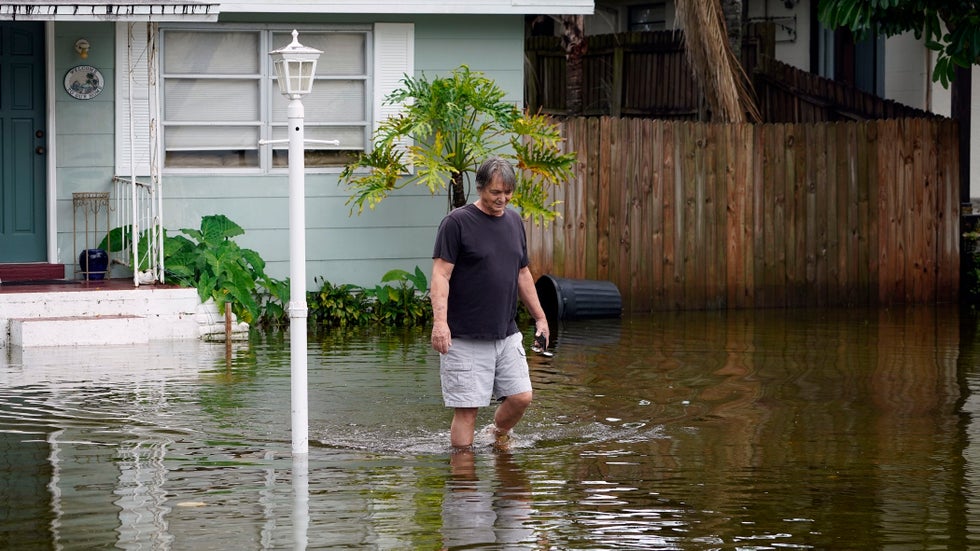Jan Wesner Childs
Some homeowners could face a massive increase in insurance costs as extreme weather and climate disasters become more frequent and more intense, according to a new report.
The study from nonprofit First Street Foundation notes that insurance on roughly 39 million properties in the United States - or about one quarter of all homes nationwide - is underpriced when it comes to climate risks like hurricanes, wildfires and flooding.
"There's a lot of people that just don't know they have that level of risk and we've seen the environment change so much in the last couple of decades that we're getting to the point that places where we built in the past are riskier than they were when we first built there," Jeremy Porter, head of climate implications research at First Street, told The Weather Channel in an interview Wednesday.
What Does This Mean For Homeowners?
 Don Hawthorne walks across his flooded yard in unincorporated Pinellas County, Fla., after the storm surge from Hurricane Idalia moved by the area, Aug. 30, 2023.
Don Hawthorne walks across his flooded yard in unincorporated Pinellas County, Fla., after the storm surge from Hurricane Idalia moved by the area, Aug. 30, 2023.Homeowners are already seeing steeper rates or a lack of availability of insurance altogether.
The First Street report and others like it aim to inform homeowners and comumunities not just about risk but also things they can do to help gird against it.
"So there's a lot of places where if we have the right data, we can allocate that information and we can allocate those resources effectively and efficiently," Porter said. "But in some places, the math just isn't going to work out and ultimately, we're going to have to relocate and move some really high-risk properties, but maybe even some high-risk communities."
The problem is most acute in states commonly hit by wildfires, flooding and damaging storms.
In areas most at-risk for wildfires in California, non-renewals for homeowners insurance have risen by 800 percent, according to First Street. Insurance companies in hurricane-prone Florida and Louisiana are leaving, refusing to issue policies in certain locations or pricing people out of the market.
Homeowners Hit With Sticker Shock
Jen Goodlin moved back to her hometown of Paradise, California, in 2020, to help in the town’s recovery from one of the most devastating wildfires in U.S. history. She and her family moved into a new house in October 2022.
In July, Goodlin received notice that the family’s homeowner insurance premium would jump from $2,500 to $11,245.
“Our insurance agent said, ‘Just be thankful we didn’t drop you,’ and I said, ‘You did, you just dropped me,’” she told The Associated Press.
Property owners like Goodlin are often driven to their state's ‘insurer of last resort,' designed to provide coverage to people turned down by traditional companies.
Citizens Property Insurance Corporation, Florida's insurer of last resort, has raised the average premium 61 percent since 2016. In Louisiana, that number is 63 percent in just the past year.
It's Not Just California, Florida And Louisiana
Even places that don’t see disasters all the time, like parts of Vermont hit hard by flooding this summer, are at risk. The federally subsidized national flood insurance program has already doubled the average premium in a dozen states.
First Street points out that some of the issues with insurance companies and prices are caused by government regulations and other factors. But regardless, climate change and extreme weather are driving more damaging and costly disasters.
"What's really worrisome is that if premiums continue to rise with risk, ultimately, we're likely to see more and more people go without insurance and risk the probabilities of being hit by one of these events," Porter said.
MORE ON WEATHER.COM
-Here's How A Warmer World Could Affect Hurricane Season
-15 Billion-Dollar Weather Disasters Hit The US This Year, A Record Pace, NOAA Says
-Why Aren't All Beach Houses Built On Stilts
-How Climate Change Drove Eastern Canada Wildfires
Weather.com reporter Jan Childs covers breaking news and features related to weather, space, climate change, the environment and everything in between.
The Weather Company’s primary journalistic mission is to report on breaking weather news, the environment and the importance of science to our lives. This story does not necessarily represent the position of our parent company, IBM.
The Weather Company’s primary journalistic mission is to report on breaking weather news, the environment and the importance of science to our lives. This story does not necessarily represent the position of our parent company, IBM.

No comments:
Post a Comment